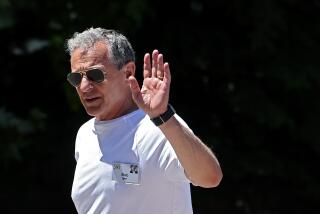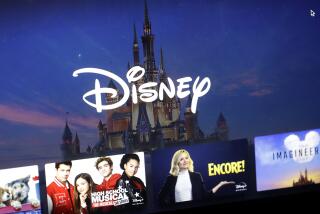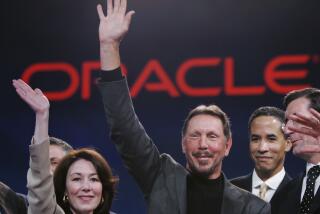How Robert Iger’s ‘fearless’ deal-making transformed Disney
On his second day on the job as chief executive, Robert Iger steeled himself for a crucial presentation to the Walt Disney Co. board of directors.
Disney was still smarting from a hostile takeover attempt, a shareholder revolt and executive suite intrigue spawned in the sunset of the Michael Eisner regime.
But there was a more urgent problem: The once-proud animation unit was in a rut.
“If I didn’t turn Disney Animation around quickly … there was a drumbeat that was going to get louder and louder in terms of whether I was worthy of the job and how long I would last and all those things,” Iger recalled confiding to his wife, journalist Willow Bay. “So I knew that the pressure was on.”
At the Oct. 2, 2005, board meeting, Iger floated an idea that would become a hallmark of his tenure. He made a risky, even audacious, proposal: What if the company bought Pixar Animation Studios?
The computer animation upstart owned by Apple’s Steve Jobs was at odds with Disney over the terms of extending the two companies’ partnership. Iger worried about the directors’ reaction to pursuing a high-stakes acquisition so soon after taking over.
“To the credit of the board, they did not throw me out of the room,” he said.
ALSO: Robert Iger on Disney’s strategy, past struggles and more
Three months later, Disney said it would buy Pixar for $7.4 billion. It was the first of three major purchases engineered by Iger, laying the foundation for the subsequent acquisitions of Marvel Entertainment in 2009 and Lucasfilm in 2012.
Fast forward to 2015, which marks the first time that each of the acquired companies is releasing a film in the same year, underscoring the central role they now play in the Disney empire.
But the acquisitions didn’t always look like sure things.
“These deals were questioned by analysts on Wall Street, including me,” said Tuna Amobi, an analyst for S&P Capital IQ. “But with the investors I speak to, the perception is that the deals could be the best deals in the media space of all time, pound for pound.”
The acquisitions are a big reason Disney’s stock price has more than quadrupled during Iger’s tenure. Beyond that, they kept Disney from a fate that has befallen many a corporate giant that tried to live off its past success. Sears Roebuck & Co., U.S. Steel, Eastman Kodak, Pan Am — the annals of American business are filled with companies that either failed or fell from their peaks because they didn’t adapt to competition and changing technology.
In the rare case of a company getting back on top, it is usually rejuvenated by an outsider — like Louis Gerstner Jr., who revived a battered IBM in the 1990s — rather than an insider like Iger, who had been at Disney for nearly a decade before becoming chief executive.
Like many successful corporate leaders, Iger, 64, decided early on to try to control events rather than react to them. To be “fearless,” as he put it in a recent interview.
“I just was built with an innate ability to not let fear guide me in how I run my life,” he said. “You can look at all the numbers in the world, but at some point somebody … needs to dig down deep, search his soul, analyze or get in touch with his own or her own instinct, and decide.”
Former colleagues say Iger possesses an expansive vision for Disney and is daring enough to act on it. He solicits opinions, notes former Disneyland International Chairman Jim Cora, but ultimately goes “where his gut tells him to go.”
FACT FILE: Robert Iger’s bio, favorite Disneyland ride and more
Iger has not been infallible. Disney’s live-action studio business has had its share of misses, including the disastrous “Lone Ranger” in 2013 and its current disappointment, “Tomorrowland.”
It also remains to be seen how Iger’s $500-million gamble last year to buy Maker Studios, which produces low-cost videos for YouTube, will pay off.
Still, if Iger were to step aside tomorrow, he would have left Disney in far better shape than when he became chief executive. Iger is expected to retire in 2018, when his contract expires, and this year Thomas Staggs was named Disney’s chief operating officer, making him the top internal candidate to become the next CEO.
Whoever it is, Disney’s next chief executive can be expected to face an entirely new set of challenges. But it’s also likely that its next leader will be studying the Iger playbook.
Aiming for Pixar
Emerging from the Oct. 2 board meeting, Iger began mapping out a possible purchase of Pixar. The next day, he directed a small group of trusted advisors, Staggs among them, to do more homework. And he told them he planned to call Jobs.
The team wasn’t sold on the idea, but Iger made the call anyway, reaching Jobs that afternoon as he drove home from Disney headquarters in Burbank.
“I said, ‘Steve, I’ve got a crazy idea,’” Iger recalled.
Iger told Jobs that he wanted to visit him to make a proposal. But Jobs insisted on knowing what was on Iger’s mind right away.
“I hesitated. I was kind of nervous, because the last thing I wanted was for him to basically hang up on me,” Iger said. At first, he struggled with how to articulate his pitch.
“I figured I might as well just cut to the chase and I said, ‘You know — Disney acquiring Pixar?’ And there was complete silence,” Iger said. “My heart was racing. And he said, ‘You know what? It’s not the craziest idea in the world.’”
Iger said the importance of Pixar to Disney’s future had become clear to him during opening ceremonies for Hong Kong Disneyland in September 2005, just a month before he became chief executive. He noticed the many characters from Pixar films featured in the kickoff parade. But there was nothing from Disney’s recent animated movies, whose latest characters weren’t popular.
“It was a light bulb at a very high wattage,” Iger recalled.
The phone conversation with Jobs eventually led to Disney’s purchase of Pixar at a 3.8% premium to its stock price. The deal, which made the mercurial Jobs Disney’s biggest shareholder, was widely questioned by analysts who believed the price was too dear.
But the acquisition arguably saved Disney Animation from a long decline that had been punctuated by flops such as 2002’s “Treasure Planet.” The animation unit’s box-office prospects were quickly lifted and Disney also netted Pixar’s leaders, John Lasseter and Ed Catmull.
In an effort to convince the animation gurus that they could thrive at Disney, Iger shared with them his own experience of working for a company that was acquired.
In 1996, Disney bought Capital Cities and its ABC TV network for $19 billion. Iger was president of the company, having risen through the executive ranks for two decades. Such acquisitions often lead to executive departures. But then-Disney Chairman Eisner retained Iger, who was promoted to president and chief operating officer of Disney in 2000.
“I was a living, breathing example of how someone could not only survive an acquisition but thrive,” he said.
And in the same way that he was given an opportunity at Disney, Iger gave Lasseter and Catmull a big one too, putting them in charge of Disney Animation. The division has since released hits including “Frozen,” the top-grossing animated film of all time.
Buying Pixar, Iger said, “was the single most important thing that has happened to me in the 10 years I’ve been in this job.”
A film giant
By most accounts, Disney is king of the hill in Hollywood. The world’s largest entertainment firm, it owns television networks, a film studio and growing theme park and consumer products businesses — all of which work together to get maximum mileage out of the company’s stable of intellectual property.
Although the financial performance of each Disney division has improved under Iger, he has arguably made his biggest impact in film. In 2005, Disney was fifth among the six major studios in domestic box-office receipts, according to Rentrak. Now it’s near the top: In 2014, Disney was No. 2 behind 20th Century Fox. So far this year, Disney again is in second place, trailing Warner Bros. by a narrow margin despite having released fewer films.
The difference? The Pixar and Marvel acquisitions, which have turbocharged Walt Disney Studios, providing the division with a slew of blockbuster franchises, including “Cars” and “Iron Man.”
Those films are exceedingly valuable to Disney because they’ve become a centerpiece of the company’s strategy of integrating intellectual property throughout its five business units.
In Disney’s hands, a movie like “Frozen,” which was released in November 2013, can spin off cash years after it exits theaters. The film’s merchandise sales, for example, were credited with helping boost the consumer products division’s operating income 32% in the quarter that ended March 28.
“Disney monetizes its content better than anyone else out there,” said Scott Krisiloff, chief investment officer at Avondale Asset Management. “They don’t just sell you the movie ticket, they sell you the figurine, the theme park ticket, they sell you on the experience.”
Disney generated $7.5 billion in profit last year, dwarfing the earnings of rivals such as Time Warner, Viacom and 21st Century Fox. (Comcast posted a bigger profit than Disney in fiscal 2014, but the bulk of that company’s net income comes from its telecommunications business.)
Iger has reaped his rewards for Disney’s success. He was paid $46.5 million last year, and he holds about 1.14 million shares of Disney stock, according to recent regulatory filings. His stock holdings were worth more than $125 million as of Friday.
But not everything Iger has touched has turned to gold. In 2009, he put TV veteran Rich Ross in charge of the film studio. Three years later, Disney parted ways with Ross after the release of “John Carter,” the poorly received sci-fi epic that resulted in a $200-million write-down. Ross had also put “Lone Ranger” into production.
But after Ross’ exit, Iger moved swiftly to correct course. He brought in a veteran studio hand, former Warner Bros. President Alan Horn.
That willingness to make a decisive move is also evident in Iger’s approach to deal-making. Iger said that when he’s considering an acquisition, he doesn’t get caught up in what-ifs.
“It’s not that I’m a daredevil,” Iger said. “But I’m just generally not a fearful person. I don’t conduct my life worrying about what could happen, what may happen.”
Pivotal purchases
The Pixar deal may be the one that established Iger’s acquisition bona fides, but Disney wouldn’t be where it is today without the Marvel and Lucasfilm purchases.
Marvel had long been a gleam in Disney’s eye. The company had a stable of popular comic book characters such as Iron Man, Spider-Man and Wolverine and by the mid-2000s had found success releasing superhero movies with rival film studios.
To get Marvel, Disney would have to convince owner Isaac Perlmutter, a sharp-elbowed Israeli- American businessman, that it was time to sell.
“Ike was difficult to reach, didn’t engage very much and never came to Hollywood,” Iger said.
Iger eventually got on Perlmutter’s schedule: They would meet in June 2009 at the inscrutable Marvel executive’s offices in Manhattan.
Iger walked into Perlmutter’s office by himself and told the story of buying Pixar, hammering on the opportunities it created. Iger also suggested that Perlmutter telephone Jobs, who could share his experience of selling Pixar to Disney.
“I basically tried to convince him that I was a trustworthy guy — not only was my handshake good but I’d be a good steward of his people and the brand,” Iger said.
He said that the $4-billion deal was effectively clinched over dinner with their wives at an Upper East Side steakhouse.
Under Disney, Marvel has released three films that have topped $1 billion at the box office: “The Avengers,” “Iron Man 3” and “Avengers: Age of Ultron.”
“Star Wars” is next.
As with the Marvel deal, Disney’s acquisition of Lucasfilm — the producer of the sci-fi franchise — hinged on a pivotal meal.
Iger and Lucasfilm owner George Lucas met for breakfast at Walt Disney World’s Hollywood Brown Derby (patterned after the long-gone L.A. eateries) in 2011 while both were in Florida to unveil a new 3-D Star Tours attraction.
Iger’s pitch invoked the successes of Marvel and Pixar and drew a tantalizing response from Lucas. “What he said to me was, ‘If there is anyone I want to sell to, it is you,’” Iger recalled.
Six months later, Lucas rang him. “Remember that breakfast?” Iger recalled Lucas saying.
The $4.06-billion deal was announced in October 2012. “Star Wars: The Force Awakens” will be released Dec. 18, the first of several new films planned for the franchise.
Producer Brian Grazer, who has known Iger for more than 25 years, believes that the executive’s toughness — “he’s kind of black ops” — has made him impervious to pressure. But it is Iger’s ability to connect personally with leaders like Lucas that may be his secret weapon, Grazer said.
“All of these guys — beginning with Steve Jobs, then Ike Perlmutter and George Lucas — are the most discriminating founders. When you are a founder, you really look for vision and trust. I think Bob has that in the highest order,” Grazer said. “That immediately gave him a competitive edge.”
Digital future
Last week, Disney gathered reporters to show off a new line of toys, called Playmation, aimed squarely at a demographic the company calls the “digital generation.” Iger didn’t preside over the reveal — those duties fell to Staggs, marking the first time he’s been given such responsibilities in his role as the company’s No. 2.
Dressed in a trim gray suit, Staggs explained how Playmation would showcase Disney film franchises, starting with “Avengers.”
“Since its inception, the Walt Disney Co. has been about imagination, innovation and storytelling,” he said.
But now more than ever, digital innovation will be important to Disney’s future. It’s almost certain that the big challenge for the next CEO of Disney won’t be animation or live-action film, as it was with Iger, but with the digital revolution.
On this front, established media conglomerates like Disney are fighting hard to establish beachheads in areas where upstarts such as Netflix and Amazon have found quick success. It’s a sea change that affects many areas of the company, but especially television, Disney’s most lucrative business.
It also remains to be seen what will come of Disney’s purchase of Maker, a major digital bet that could end up costing Disney as much as $950 million if the company meets certain goals.
The presumption of many is that these will be battles for Staggs, now seen as the internal front-runner for the CEO job. But his ascension is not preordained: Between now and 2018, his leadership will be scrutinized by Disney’s board, which will select the company’s next leader. The company could also eye an outsider for the job.
Staggs seems to be cut from the same cloth as Iger. Both are fitness buffs, both are experienced in acquisitions (Staggs was involved in the Capital Cities/ABC deal) and are said by former colleagues such as Cora to have a similar management style.
“He listens to people, he trusts those who work for him or those in other divisions of the company,” Cora, the former Disneyland International chairman, said of Staggs. “He gathers opinions too.”
Similar or not, Iger, who was made Disney’s chairman in 2012, has set the bar high, and his successor will have to contend with outsized expectations. Disney’s successes have been so grand and so regular — it has delivered record net income, earnings per share and revenue four fiscal years in a row — that Wall Street has become accustomed to home runs.
That’s a heavy burden for any CEO.
Iger, in talking about the risk of acquisitions, noted that the chief executive is always the one in the spotlight.
“Yes, you’re putting risk on a company,” he said. “But from a reputational perspective, no one is taking on more risk than the CEO. And it’s a risk that is personal and firmly tethered to a CEO.”
Twitter: @danielnmiller
More to Read
From the Oscars to the Emmys.
Get the Envelope newsletter for exclusive awards season coverage, behind-the-scenes stories from the Envelope podcast and columnist Glenn Whipp’s must-read analysis.
You may occasionally receive promotional content from the Los Angeles Times.








